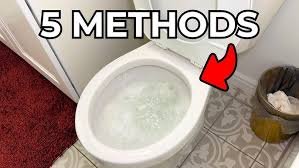
A clogged toilet is one of the most common plumbing issues people face. Whether it happens at home or while you’re visiting a friend, a toilet that won’t flush properly can cause significant inconvenience. Luckily, learning how to unclog a toilet is something you can tackle on your own. There are several effective methods you can use depending on the cause and severity of the blockage. In this comprehensive guide, we’ll walk you through everything you need to know about how to unclog a toilet, providing you with step-by-step instructions, helpful tips, and tools you may need.
Table of Contents
Understanding the Causes: What Leads to Toilet Clogs?
Before diving into the various techniques on how to unclog a toilet, it’s essential to first understand why clogs happen. Knowing the cause can help you prevent future issues and choose the right method for dealing with a blockage.
- Excessive Toilet Paper: Toilet paper is designed to break down easily in water, but flushing too much at once can easily overwhelm the system, causing a blockage.
- Foreign Objects: Flushing items like wet wipes, toys, paper towels, or sanitary products can easily cause a clog. Even if an item is labeled “flushable,” it can still cause problems.
- Low Water Pressure: If the water in the toilet bowl is too low or doesn’t have enough pressure, the flush may not be powerful enough to clear waste from the bowl, leading to a clog.
- Mineral Buildup: Over time, minerals in hard water can accumulate in your pipes, creating slow drains or even complete blockages.
Understanding these causes can help guide your approach when figuring out how to unclog a toilet.
The Tools You’ll Need to Unclog a Toilet
Several tools and methods are available to unclog a toilet, depending on the severity of the blockage. Some are household items, while others are specialized tools. Here’s a breakdown of the most common tools you’ll need for how to unclog a toilet:
- Plunger: The most common tool for unclogging toilets. It creates a vacuum that can push the clog through the pipes.
- Toilet Auger: A flexible, snake-like tool designed to break up or retrieve deeper clogs.
- Baking Soda and Vinegar: A natural solution that can break down some clogs.
- Dish Soap and Hot Water: A simple and effective way to break down blockages, especially for paper-related clogs.
- Drain Cleaner: A chemical solution that can dissolve clogs, but should be used with caution.
Step-by-Step Instructions on How to Unclog a Toilet

Now that we’ve covered the causes and tools, let’s go into detail on how to unclog a toilet using a variety of methods. Some methods are quick and easy, while others may require a little more elbow grease.
1. Using a Plunger to Unclog a Toilet
The first and most commonly used tool when it comes to how to unclog a toilet is the plunger. This tool works by creating suction and pressure to move the clog.
Steps to Use a Plunger:
- Choose the Right Plunger: For toilets, make sure you’re using a toilet plunger, not a sink plunger. Toilet plungers have a flange that fits into the drain and creates a better seal.
- Submerge the Plunger: Position the plunger in the toilet bowl and ensure the rubber cup is fully submerged. The plunger should cover the drain hole completely to create the best seal.
- Plunge Up and Down: Push the plunger down, then pull up sharply. Repeat this action several times to create pressure and suction. Ensure that the plunger stays submerged during the motion to maximize suction.
- Check the Results: After a few plunges, flush the toilet. If the water drains, the clog is cleared. If not, repeat the process.
This method is often the quickest and most effective way to unclog a toilet.
2. Using a Toilet Auger for Stubborn Clogs
If a plunger doesn’t work or the clog is deeper in the pipes, a toilet auger is your next option. A toilet auger is designed to break up or retrieve blockages that are harder to reach.
Steps to Use a Toilet Auger:
- Insert the Auger: Feed the auger’s cable into the toilet bowl and gently push it down the drain while rotating the handle.
- Break Up the Clog: Once you encounter resistance, you’ve likely hit the clog. Rotate the auger handle to break up or snag the blockage.
- Retrieve the Clog: If the clog is large enough, you may be able to pull it out with the auger. If not, continue to rotate the auger until the blockage is broken down or moved.
- Flush the Toilet: After you’ve either broken up or removed the blockage, flush the toilet to check if it drains properly.
A toilet auger is a very effective tool for how to unclog a toilet, especially if the clog is deeper in the pipes or caused by an object that’s hard to move.
3. Using Hot Water and Dish Soap to Unclog a Toilet
Sometimes a combination of hot water and dish soap can help to loosen a blockage, especially when the clog is caused by toilet paper or other soft materials.
Steps to Use Hot Water and Dish Soap:
- Add Dish Soap: Pour about a cup of dish soap into the toilet bowl. The soap will help lubricate the pipes and break down waste.
- Heat Water: Boil about a gallon of water, making sure it’s not too hot to avoid damaging the porcelain.
- Pour the Water: Slowly pour the hot water into the toilet bowl from waist height, which will help add pressure to the clog.
- Wait: Allow the mixture to sit for at least 20-30 minutes. The heat and soap will work together to break up the clog.
- Flush: After waiting, flush the toilet to see if the clog has cleared.
This method is great for minor clogs and is one of the more natural ways to unclog a toilet.
4. Using Baking Soda and Vinegar to Unclog a Toilet
Baking soda and vinegar are often used as a natural solution for cleaning drains and breaking down blockages.
Steps to Use Baking Soda and Vinegar:
- Add Baking Soda: Pour about a cup of baking soda into the toilet bowl.
- Add Vinegar: Pour 2 cups of vinegar into the bowl. You’ll see fizzing as the two substances react.
- Wait: Allow the mixture to sit in the toilet for 30 minutes or longer. The fizzing action will help break down organic materials in the clog.
- Flush: After waiting, flush the toilet to see if the blockage has cleared.
This method works particularly well for clogs caused by organic materials, such as toilet paper or waste.
5. Using a Commercial Drain Cleaner
If the above methods fail and you’re dealing with a stubborn clog, a commercial drain cleaner might be the solution. These products use chemicals to dissolve blockages and restore water flow.
Steps to Use a Drain Cleaner:

- Read Instructions: Follow the directions on the product label carefully. Each cleaner has different application instructions.
- Pour the Cleaner: Pour the drain cleaner into the toilet bowl, making sure it’s in contact with the clog.
- Wait: Allow the cleaner to sit in the toilet for the recommended time, usually anywhere from 30 minutes to an hour.
- Flush: After the recommended wait time, flush the toilet. If the blockage is cleared, the water should drain smoothly.
Commercial drain cleaners are effective but should be used sparingly because they can damage pipes if overused.
6. When to Call a Plumber
If you’ve tried all the methods mentioned and the clog persists, it might be time to call a plumber. Persistent clogs could indicate a larger issue, such as a broken sewer line, tree root intrusion, or a buildup of mineral deposits in the pipes.
Signs You Need a Plumber:
- Multiple Clogged Drains: If other drains in your home are also clogged, the issue could be a bigger plumbing problem.
- Unsuccessful DIY Methods: If plunging, using an auger, or natural methods haven’t worked, professional tools may be necessary.
- Frequent Clogs: If you find yourself dealing with clogs on a regular basis, it may be time to have your pipes inspected for potential issues.
Preventing Toilet Clogs in the Future
Once you’ve learned how to unclog a toilet, it’s important to take steps to prevent clogs from occurring again. Regular maintenance and small adjustments can help avoid the need for emergency plumbing work.
- Use Toilet Paper Sparingly: Limit the amount of toilet paper used in one flush to avoid overwhelming the system.
- Avoid Flushing Foreign Objects: Never flush wipes, feminine hygiene products, or other non-biodegradable items.
- Consider a Low-Flow Toilet: These toilets use less water, which can help prevent clogs and save on your water bill.
- Regular Plumbing Maintenance: Have your pipes checked periodically to ensure there are no underlying issues.
Also read Fairy Lights A Guide to Their History, Uses, and Benefits
Conclusion
Knowing how to unclog a toilet is a valuable skill every homeowner should possess. Whether it’s a simple clog or a more serious issue, there are several techniques available to resolve the problem. From plungers and augers to natural remedies like baking soda and vinegar, you have plenty of options to clear the blockage yourself. However, for more severe clogs or plumbing issues, don’t hesitate to call a professional plumber. By following the right steps and taking preventive measures, you can keep your toilet functioning properly and avoid future clogs.




